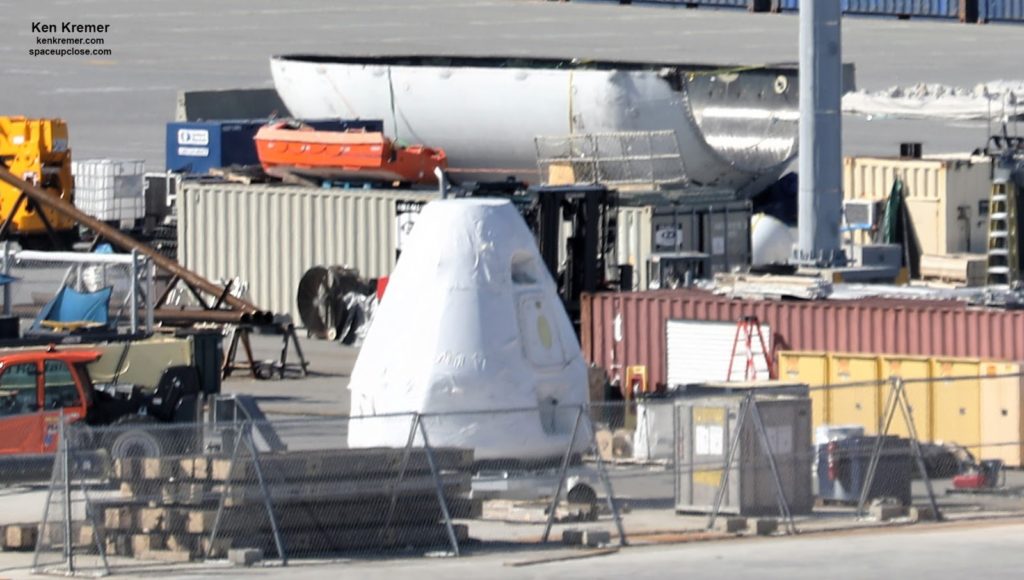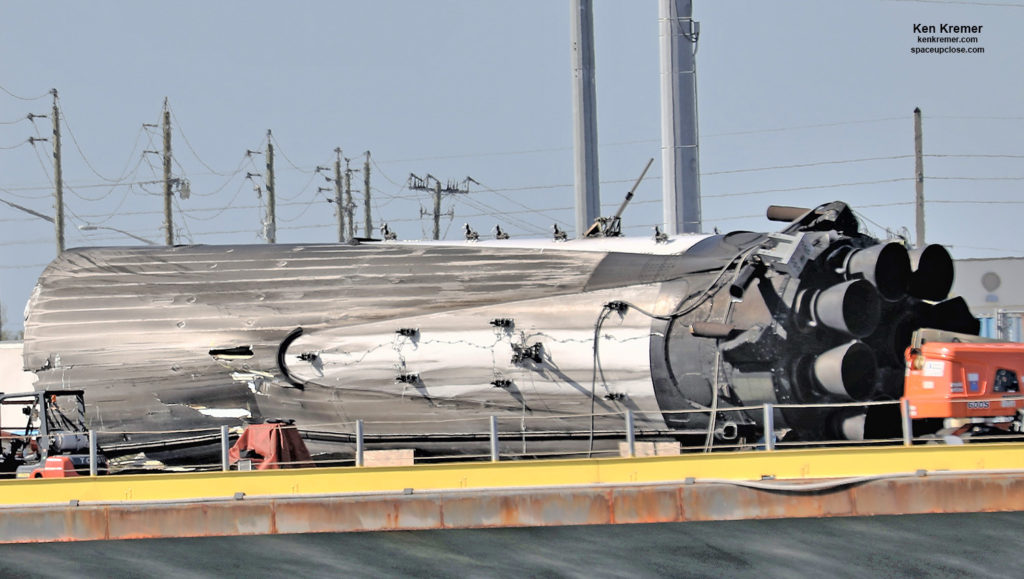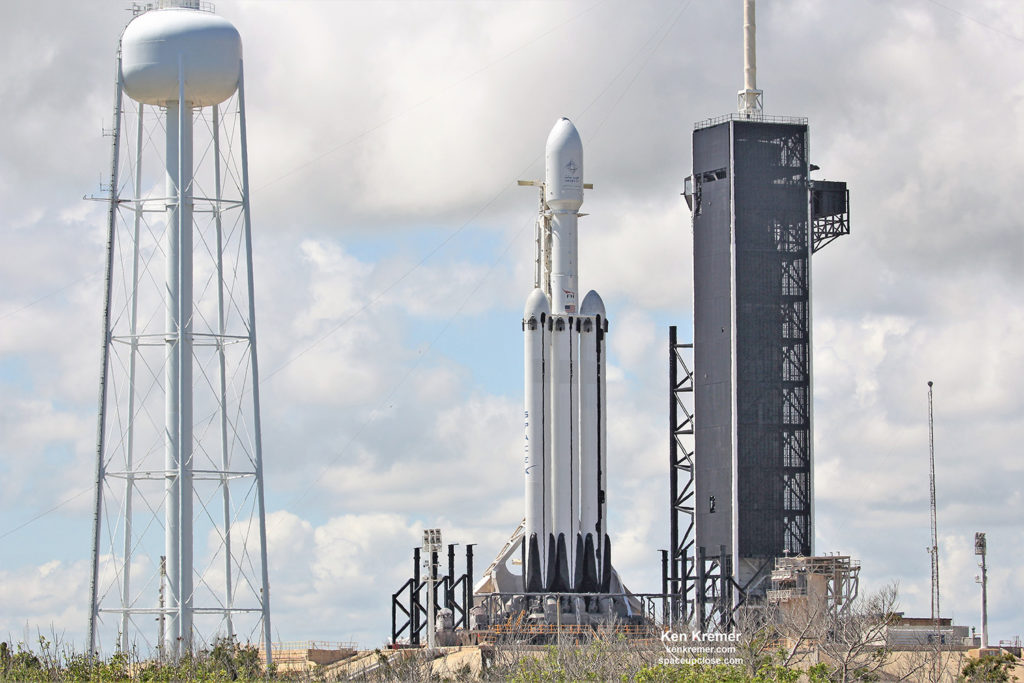Kremer — SpaceUpClose.com &
RocketSTEM – 30 April 2019
PORT CANAVERAL, FL – The wrecked core booster from the triple
stick SpaceX Falcon Heavy that successfully landed on a droneship shortly after
launching April 11 but subsequently toppled over due to rough seas and was destroyed while
returning to Port Canaveral, eventually arrived back in port – resting
horizontally on the deck of the OCISLY droneship.
I saw the booster on Easter
Sunday April 21 several days after it arrived around 2 a.m. on April 18, since I was away covering the beautiful launch of the Northrop Grumman commercial
Antares rocket that successfully delivered the Cygnus NG-11 cargo freighter to crew
aboard the International Space Station (ISS).
Check out my gallery of photos of the core
stage taken on Easter Sunday, April 21.
the bottom half of the Falcon Heavy core stage were still sitting horizontally on
OCISLY fully exposed to the elements – with no protective sheeting and subject
to frequent Florida Space Coast wind and rain storms.
In fact the booster was still visible in Port
yesterday a week later – although it had at last been craned off OCISLY onto
land behind the droneship. The droneship
had to be cleared for use in the next launch and landing currenty slated for
NET Friday May 3.
All nine Merlin 1 D engines were still attached
at base of the Falcon Heavy booster.
Several of the engines were clearly dented
and crumpled and likewise were also completely uncovered.
It’s hard for me to believe that those Merlin
engines will ever be recycled to another rocket launch – as CEO Elon Musk
hinted at in a tweet.
However the Merlin engines and core stage remains
would certainly be extremely valuable in science and engineering evaluations
and analysis for proof testing, corrosion, lifecycle, endurance, resilience and
reusability.
cylindrical component can ever fly.
three of the four landing legs were still attached.
pickers quickly detached the landing legs.
used for recovery practice from the ocean as were also visible at the port – lying
on the ground atop a cradle just behind the droneship.
 |
|
Credit: Ken Kremer/kenkremer.com/spaceupclose.com
|
The 15 story tall center booster that successfully
made a dramatic soft landing on the “Of Course I Still Love You” (OCISLY) drone
ship several hundred miles off shore in the Atlantic Ocean toppled over at some
point over the weekend because of hefty eight to ten foot sea swells.
The booster slipped and slided atop OCISLY because
teams were unable to secure it tightly with the octagrabber robot that would
have clamped onto it firmly atop the droneship deck.
booster but in this case was unable to grasp the landed Falcon Heavy core booster
because its geometry is different from a normal Falcon 9 booster or the twin side
boosters that made a successful soft landing on the ground back at Cape Canaveral.
to rough sea conditions, SpaceX’s recovery team was unable to secure the center
core booster for its return trip to Port Canaveral,” SpaceX spokesman James
Gleason told Space UpClose.
“As conditions worsened
with eight to ten foot swells, the booster began to shift and ultimately was
unable to remain upright.”
The octagrabber system generally
used to stabilize the booster on the droneship was not able to be used for this
mission due to the center core having a different mechanical interface. Despite
that SpaceX still plans to use this system for their next Falcon Heavy launch
on mission #3.
This Falcon Heavy rocket
successfully launched the Arabsat-6A payload to orbit on April 11 at 6:36 p.m.
ET on its first commercial mission from Launch Complex 39A (LC-39A) at NASA’s
Kennedy Space Center in Florida. Read
our complete launch and landing story here.
Powered by 27 first stage Merlin 1D engines the
23 story tall Falcon Heavy behemoth thundered off pad 39A into picture perfect
skies to the cheers of the SpaceX team and well as to the tens of thousands of
spectators who flocked to Florida Space Coast beaches, parks, roadways and restaurants
– crowding into any open spot available to get an eyewitness birdseye view of
this not to be missed space spectacle.
And for the first time
in history all three Falcon Heavy launched boosters soft-landed successfully as
well.
It was a happy case of ‘3
Up, 3 Down.’
being towed back to Port Canaveral for refurbishment and eventual reuse on a second
Falcon Heavy mission planned to launch in a few months but no earlier than June.
“While we had hoped to
bring the booster back intact, the safety of our team always takes precedence.”
Despite the loss of the
core booster, that second Falcon Heavy mission is still on the manifest because
a new Falcon Heavy center core is being manufactured in case this one had not touched
down upright on OCISLY.
“We do not expect future
missions to be impacted,” Gleason added.
This launch also marked the debut of the first
all Block 5 version of Falcon Heavy compared to all Block 4 Falcon 9’s for the
maiden liftoff 14 months ago in Feb. 2018
feet (70 meters) tall. The first stage is powered by a trio of Falcon 9 rockets
lashed together and a combined total of 27 Merlin 1-D engines fueled with
liquid oxygen and RP-1 kerosene and generate 1.7 million pounds of liftoff thrust
each at ignition.
5.1 million pounds of thrust at sea level.
vacuum.
minutes after liftoff and the center core nearly 10 minutes after liftoff.
payload fairing halves.
fairing halves recovered. Will be flown on Starlink mission later this year,” SpaceX
CEO and billionaire founder Elon Musk tweeted.
several nitrogen thrusters & steerable parachutes.”
Thus SpaceX plans to reuse the side booster
and fairings on upcoming launches.
Musk aims to drastically cut the high cost
of access to space by recovering and reusing the first stage boosters and engines,
fairing and more of the SpaceX Falcon family of rockets.
Watch my Falcon
Heavy prelaunch commentary
for 1st SpaceX launch attempt April 10 – in these two News 6 WKMG / ClickOrlando TV News reports from
correspondent James Sparvero
Meanwhile NASA and
SpaceX prepare to launch the next Falcon 9 rocket and the Dragon CRS-17 supply
ship to the ISS on Friday, May 3 at 3:11 a.m. EDT from pad 40 at Cape
Canaveral.
onsite coverage of NASA, SpaceX, ULA, Boeing, Lockheed Martin, Northrop Grumman
and more space and mission reports direct from the Kennedy Space Center, Cape
Canaveral Air Force Station, Florida and Wallops Flight Facility, Virginia.
Planetary science and human spaceflight news: www.kenkremer.com –www.spaceupclose.com – twitter @ken_kremer
– email: ken at kenkremer.com
KSC area, active in outreach and interviewed regularly on TV and radio about
space topics.
Ken’s photos are for sale and he is available for lectures and outreach events
more about the upcoming/recent SpaceX
Falcon 9/CRS-17 launch to ISS, Falcon Heavy, SpaceX Demo-1 launch/test failure,
SpaceX Beresheet launch, NASA
missions, ULA Atlas & Delta launches, Northrop Grumman Antares, SpySats and
more at Ken’s upcoming outreach events at Quality
Inn Kennedy Space Center, Titusville, FL, evenings:
“SpaceX Falcon 9 CRS-17 resupply launch to ISS, Demo-1, Beresheet launches, SpaceX Falcon Heavy launches, upcoming SpaceX
Falcon 9, ULA, NRO & USAF Spysats, SLS, Orion, Boeing and SpaceX Commercial
crew capsules, OSIRIS-Rex, InSight Mars lander, Curiosity and Opportunity explore
Mars, NH at Pluto, Ultima Thule and more,” Kennedy Space Center Quality Inn,
Titusville, FL, evenings. Photos for
sale








